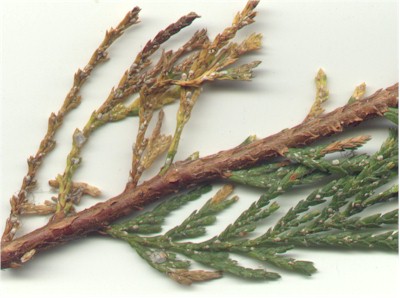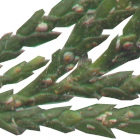 Common Name(s): Juniper Scale
Common Name(s): Juniper ScaleJuniper Scale |
 Common Name(s): Juniper Scale
Common Name(s): Juniper Scale
Scientific Name(s): Carulaspis juniperi or Carulaspis minima
Type: Insect.
Principle Host Trees & Shr
ubs:Juniper (Juniperus), Leyland Cypress (Cuppressocyparis), Lawson Cypress (Chamaecyparis), Western Red Cedar (Thuja) and all members of the Cupressaceae family.
Description, Development & Diagnosis:
 This is an insect which feeds on the sap within the stem or leaf. The insects use
a small covering (scale) to protect themselves as they feed. They consist of the larger
rounded female scale which is approximately 1-2mm in diameter and white in colour with a
notable, central yellow spot and the smaller male scale which has a more elongated
appearance. Their feeding can reduce the vigour of the foliage supported by that stem and
this may cause the foliage to turn yellow or even brown (dead).
This is an insect which feeds on the sap within the stem or leaf. The insects use
a small covering (scale) to protect themselves as they feed. They consist of the larger
rounded female scale which is approximately 1-2mm in diameter and white in colour with a
notable, central yellow spot and the smaller male scale which has a more elongated
appearance. Their feeding can reduce the vigour of the foliage supported by that stem and
this may cause the foliage to turn yellow or even brown (dead).
The small photograph shows the larger female scales adjacent to the smaller elongated males. [Note the nearly central spot on the female scale - see same photograph, enlarged at foot of page].
Significance:
This is a very common disease of these trees. A severe infection can cause death of foliage (see top photograph) which can produce unsightly brown patches on formal garden hedges (aphids can also be a cause of such dead patches).
Control:
Spray severely affected areas with malathion insecticide in early summer (June-July) to kill the newly hatched (and more vulnerable) nymphs. Dead areas of foliage can be removed (take care to make sure they are completely dead) which will remove any attached insects and give adjacent areas of live foliage more space to grow.

| Further Information. |
© 2001 Chris Skellern. AIE. Home | News | A-Z Index | Resources | Contact AIE | Terms of Use